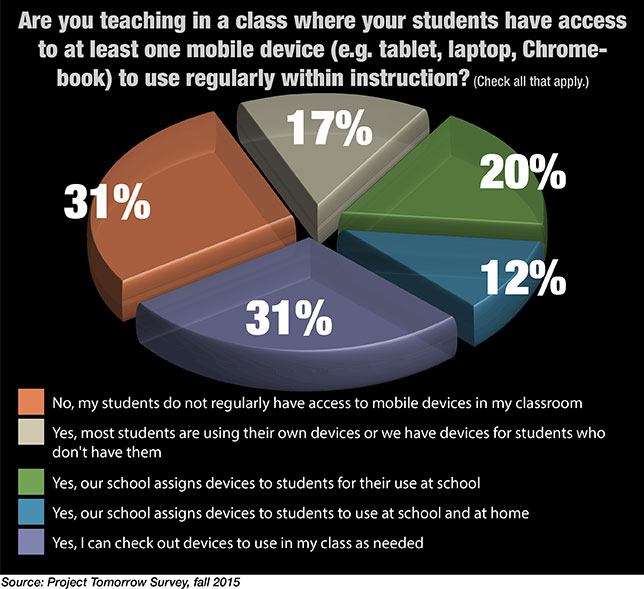How Teachers Leverage Mobile Technology
Despite widespread acknowledgment of the advantages of mobile computing, students in nearly one-third of classrooms do not have regular access to mobile devices in the classroom — this according to exclusive data released to THE Journal by the national education nonprofit Project Tomorrow.
Project Tomorrow has been collecting data on the use of technology in American schools on a massive scale for more than a decade. Since 2003, the organization’s Speak Up Research Project has involved more than 4.5 million participants — teachers, parents, students, administrators and technology professionals — from more than 35,000 schools representing all 50 states.

A survey involving more than 38,000 teachers and librarians conducted last fall revealed that 49 percent of educators’ schools assign devices to students for use in the classroom or allow those students to use their own, and another 31 percent have devices available for checkout as needed.
Survey participants cited a number of advantages for using mobile devices in the classroom, including enhancing student engagement in school and learning (77 percent), extending learning beyond the school day (74 percent), providing access to online textbooks (72 percent) and providing a way for students to review class materials after school (70 percent).
| |
Many schools are exploring how to leverage mobile devices
such as laptops and tablets to improve student achievement.
What would be the benefits of incorporating such devices
into instruction? (Check all that apply) |
| 77% |
Increases student engagement in school and learning
|
| 74% |
Extends learning beyond the school day
|
| 72% |
Access to online textbooks
|
| 70% |
Provides a way for students to review class materials after school
|
| 68% |
Student ownership of learning
|
| 66% |
Improves teacher-parent-student communications
|
| 62% |
Helps teachers improve their technology skills
|
| 59% |
Provides personalized instruction for each student
|
| 57% |
Provides opportunities for informal remediation
|
| 56% |
Students develop critical thinking and problem solving skills
|
| 55% |
Provides a way to create a learning centered environment
|
| 50% |
Students develop collaboration and teamwork skills
|
| 48% |
Increases teacher productivity
|
| 45% |
Students develop stronger communication skills
|
According to Julie Evans, CEO of Project Tomorrow, “Teachers and administrators continue to see the No. 1 benefit of any digital tool, content or resource as enhancing student engagement. While that is interesting, it has limited value. Lots of thing can engage kids — that does not necessarily point to an academic benefit or value proposition on its own. So, I always acknowledge the engagement benefit but look deeper at other benefits that can shed new insights into how the teachers are leveraging these powerful devices to transform education — or to change the trajectory of the learning process for their students. I think the more interesting benefit responses from teachers are these since they imply directly or indirectly a change in ways teachers see instruction, the way teachers interact with students or how students see their ‘job’ as learners.”
She noted that among the more interesting or meaningful benefits were:
-
Improvement of communications between stakeholders, such as the ability for students to ask question via e-mail. “Stronger communications between students and teachers is a huge benefit — one that has a lot of research behind it as a way to increase student achievement. The power of the relationship, the power of communicating about what they are learning, the power of linking the family into the school process. All big impacts,” Evans told THE Journal.
-
Extending learning beyond regular school hours: “Teachers giving that high marks as a real or perceived benefit means that they are also looking for ways to extend learning time beyond the school day but realize that kids need a device to make that a reality.”
-
Student ownership of the learning process: “Students who are using mobile devices in class are empowered/enabled to be in the driver’s seat of their own learning — to search for information on topics that interest them, to work at their own pace, to do self-remediation if needed, to connect with classmates and exchange ideas…. And they can do all of that without needing adult or teacher facilitation or sponsorship. The fact that teachers are identifying this as a benefit I think means that there is an opening to redesign the power structure in classrooms where the student is no longer the empty vessel waiting for teacher input — but rather an engaged and active participant in the learning process. This redesign mandates a new mindset about thinking about the relationship of the teacher to the student — and I think we are seeing the beginnings of that trend with this benefit.”
The survey from which these data were taken was conducted in fall 2015 and involved, according to the organization, “415,686 K–12 students, 38,613 teachers and librarians, 4,536 administrators, 40,218 parents and 6,623 community members representing over 7,600 schools and 2,600 districts. Schools from urban (25 percent), suburban (40 percent) and rural (35 percent) communities are represented. More than half of the schools (58 percent) that participated in Speak Up 2015 are Title I eligible schools (an indicator of student population poverty).”
Project Tomorrow’s latest Speak Up Survey runs Oct. 12 through Dec. 16.
To participate and view results from past surveys, visit tomorrow.org.